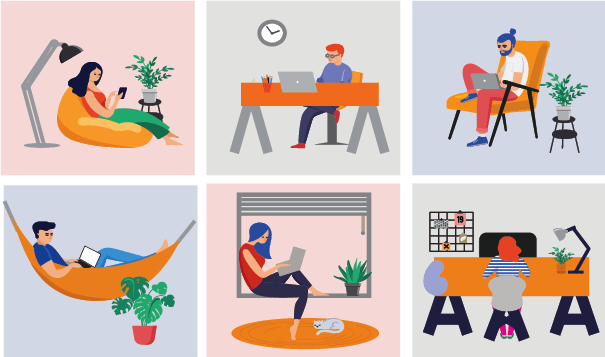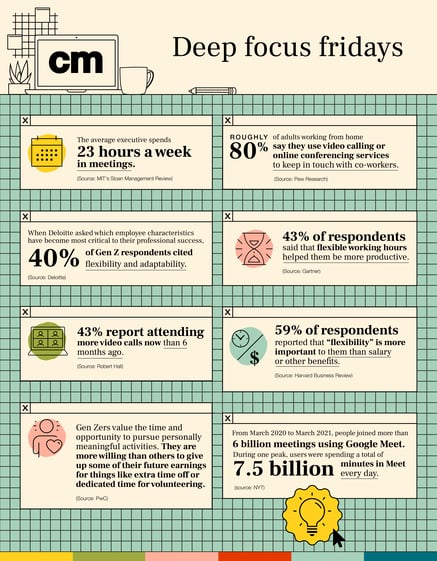Written by
Lindsay Gray & Melissa Lohrer
We’re entering a revolution for work. Everything is changing, from where we work, to when we work, and how we work.
Major shifts in the workplace used to seem far reaching — maybe even impossible or reserved only for innovative startups. But in truth, this revolution has been in motion for some time, and has been accelerated by a period where all companies have been forced to innovate or become obsolete.
After performing out of our East Village studio for over 20 years, our workplace model has adapted to being hybrid, giving us the ability to bring together talent and perspectives that stretch from local to global and on-site to nomadic. Today, we are designing our work around the people versus fitting people around the work because the new currency is talent — good talent that stays.
We all have the opportunity to reimagine what the future of the workplace could look like. This revolution is not optional, but rather essential for the future success of organizations.
We’re seeing it unfold before our eyes as we learn more about movements on the 32-hour workweek or the Great Resignation extending as companies plan on returning to the 9-5 office work week.
We don’t claim to have it all figured out, but as we look at companies that are actively innovating and reimagining their futures, we see a few key themes that opening our minds:
1. Being more resourceful with time & space
2. Considering the benefits of slow productivity
3. Reimagining people dynamics
Time & space
The hours we work and the concept of the office was designed over a hundred years ago. A very functional concept, you showed up, worked for 8 hours, took a lunch break in between, and went home to resume your personal life.
The fact is that, in today’s world, the nature of the workday and the workplace is much more dynamic.
.jpg?width=289&name=kornel-mahl-mV4GwTDD8Tw-unsplash%20(2).jpg) _______________________________
_______________________________
We work in person and
virtually, solo and in teams,
and across multiple digital platforms that create an
"always on" expectation.
_______________________
As all of these dimensions converge at once , it begs the question — is a century-old model holding up in our modern world? The quick answer: no.
In a poll to more than 65,000 North American employees, McKinsey and Lean In found employees describing feelings of burnout “often” or “almost always”. In addition to burnout, this model is leading to lack of loyalty as talent moves around in search of a better setup, and a generation left feeling unfulfilled.
When we think about where we work — if the pandemic has taught us anything, it’s that we have the ability to adapt quickly and work from anywhere. Without undermining the severity of the pandemic, remote work gave many people around the world an opportunity to be mobile and work from new places. For many, there was a newfound sense of freedom as they discovered they didn’t have to do the same daily routine and even had the ability to tackle quick personal tasks throughout the day while still managing their schedules respectfully.

Companies that are ready to lean into this shift may discover a deeper level of trust from their employees as they embrace the fact that people don’t have to be in the same physical space to deliver quality work.
Further, differences in where employees live brings more diversity of thought and experiences. Whether coming from a city setting or a rural environment, one coast or another, there is huge value in bringing together different perspectives in today's global economy.
Those who do return to a local office regularly or "main base" occasionally, should treat it as a place that is supplemental to our at-home experience. The role of the office doesn’t have to be the place where all work happens. If you’re able to experience more quiet time at home, perhaps your future office is designed for creative sprints and collaboration. If home life is hectic, perhaps your office space is where you retreat for heads down work time.
At the core of it, we must consider the individual - how and when do different people perform best? Some are better at monotonous tasks like emails in the morning hours, but their creativity shines in the afternoon or evening. We recognize we can’t have completely individualized schedules, but finding the balance between what works for the group vs. the individual will create a culture where people are able to be their best, most effective selves throughout the day.
Slow productivity
How we structure our work is also ripe for change. Working with teams across time zones and realities of everyday life has shown us that we can redesign our days in a way that works for us, not against us. We need flexibility, including off-camera time and uninterrupted focus time.
The concept of Slow Productivity, discussed in an article in The New Yorker interests us.
“In a twenty-first-century office role, the situation is reversed. You now have almost total control of how you fill each minute…this autonomy has allowed modern knowledge work to evolve haphazardly toward an increasingly unsustainable configuration. The issue in this evolution is not how many hours you’re now asked to work but the volume of work you’re assigned at any one time.”

What if, instead of cramming more work into less time, we created more space to go deeper? To finally complete a project with full focus and commitment. We’ve been drawn to this concept of slow productivity and believe it will be one of the drivers of the future workplace.
We've become addicted to a mindset of doing instead of thinking. That you will feel accomplished by getting many tasks done rather than feeling fulfilled by doing fewer, more focused projects well.
The key will be in training ourselves to work differently — to embrace slow, deep work and balance the fast work, only taking on new work after completing what you’ve started.
The other key to success with the concept of slow productivity is leaders providing a clear and manageable list of priorities. We all feel the mounting pressure in today’s work environment of doing more in less time - all while, the list of priorities keeps getting longer, pushing us to work in ways that are ineffective in order to get it done. The result? We’re left in a cycle of feeling unfulfilled, overwhelmed, and burnt out. On top of that, employees are given the responsibility of choosing how to use their time across all these projects and prioritization becomes a struggle.
In response, leaders must provide a new framework, consistently resetting the focus for the short-term while keeping the team driving towards the long-term vision.
Ultimately, the advantage we see with slow productivity is training ourselves to work differently, whether you are the one assigning or receiving work. We need to allow ourselves to work smarter, not harder. In turn, we believe this shift will help employees feel energized, empowered, and confident in the work they’re delivering. If we can help each employee feel more productive, it will positively and directly impact the overall productivity and success of the company.
People dynamics
How do we navigate human dynamics when we can’t always work together in person? We believe it requires an ability to architect natural and organic moments.
In the past, you saw colleagues regularly. Decisions could be made while passing in the hallway, issues could be ironed out quickly with an impromptu meeting, and meetings were a matter of rounding up the right people and sitting in a room to hash things out. But how do we manage the dynamics of people when time and space are moving parts?
---------------------------------------
In a hybrid world,
we have to make an effort to create opportunities for both serendipitous and planned moments for connection.
-----------------------------------
Consider compartmentalizing the platforms and formats you use purposefully - Slack Huddles and phone calls for casual chats, Zoom calls for more formal, agenda-driven meetings.
When thinking about the types of calls or meetings you have, it’s also important to understand how individuals work best and the intention of each call. Do they work better collaboratively or need to reflect on feedback ? Is the intention of the meeting to let all ideas flow freely and build something together? Or is the meeting about focusing on a few final choices? If the intention is not set from the start, you may find employees brainstorming and bringing up new thoughts when the true goal of the meeting was to make final decisions.
Other tactics may be more challenging, but extremely important. Giving your undivided attention when you’re on virtual calls is critical. Similar to reading the room when you were IRL, it’s important to avoid multitasking during virtual calls so you can be present, actively listen to what people are saying. Conversation may lead to moments of unlock, and hyper listening may spark your ability to read the room, engage, and react as you used to in person, while experiencing a natural sense of connection.

We're in the middle of the evolution towards the future and there is no blueprint for success.
We continue to stand by our commitment since the beginning of the pandemic: to move toward a future where work is fluid and collaboration can happen effectively in-person or remotely.
Worthwhile Change Takes Time
We don’t claim to have cracked it, but being a small independent company has allowed us to experiment and play with new concepts. Our newly introduced Deep Focus Fridays — a day when no external meetings can be scheduled — has given our teams the time and space they need to be heads down on our clients’ business and make time for reflection and spontaneous collaboration where ideas can fully take shape.

Whether you are reconsidering the use of time and space, how to promote slow productivity, or reimagining people dynamics, it’s important to remember it might not happen overnight.
What’s more important is ensuring all people at the organization are aware of the movements you’re making, and that change starts at the top. One team cannot feel empowered to embrace these new ways of working if they’re not seeing it happen at the leadership level. Employees want to know they’re supported in trying new ways and be held accountable for the actions they take. Over time, innovating on business practices, tools, and ways of working will be essential ingredients to continued growth & success.